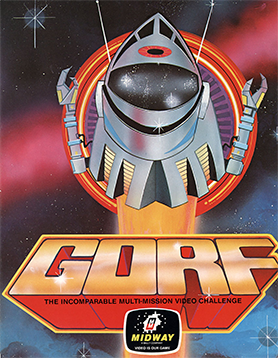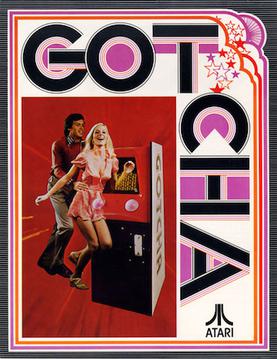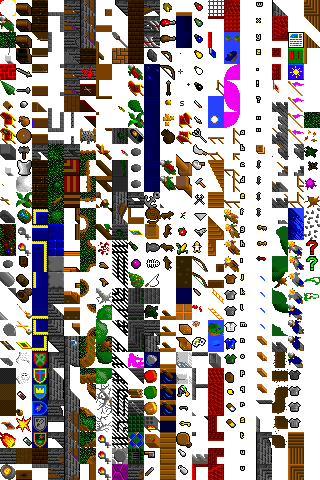
MIDI Maze, also known as Faceball 2000, is a networked first-person shooter maze game for the Atari ST developed by Xanth Software F/X and released in 1987 by Hybrid Arts. The game takes place in a maze of untextured walls. The world animates smoothly as the player turns, much like the earlier Wayout, instead of only permitting 90 degree changes of direction. Using the MIDI ports on the Atari ST, the game is said to have introduced deathmatch combat to gaming in 1987. It also predated the LAN party concept by several years. The game found a wider audience when it was converted to Faceball 2000 on the Game Boy.
Shoot 'em ups are a sub-genre of action games. There is no consensus as to which design elements compose a shoot 'em up; some restrict the definition to games featuring spacecraft and certain types of character movement, while others allow a broader definition including characters on foot and a variety of perspectives.
An action game is a video game genre that emphasizes physical challenges, including hand–eye coordination and reaction time. The genre includes a large variety of sub-genres, such as fighting games, beat 'em ups, shooter games, rhythm games and platform games. Multiplayer online battle arena and some real-time strategy games are also considered action games.

Pitfall! is a video game developed by David Crane for the Atari 2600 and released in 1982 by Activision. The player controls Pitfall Harry, who has a time limit of 20 minutes to seek treasure in a jungle. The game world is populated by enemies and hazards that variously cause the player to lose lives or points.

Defender is a horizontally scrolling shooter developed by Williams Electronics in 1980 and released as an arcade video game in 1981. The game is set on either an unnamed planet or city where the player must defeat waves of invading aliens while protecting astronauts. Development was led by Eugene Jarvis, a pinball programmer at Williams; Defender was Jarvis's first video game project and drew inspiration from Space Invaders and Asteroids. Defender was demonstrated in late 1980, before entering production in early 1981. It was distributed in Japan by Taito.

Gorf is an arcade video game released in 1981 by Midway Manufacturing, whose name was advertised as an acronym for "Galactic Orbiting Robot Force". It is a fixed shooter with five distinct levels, the first of which is based on Space Invaders and another on Galaxian. The game makes heavy use of synthesized speech for the Gorfian robot which taunts the player, powered by the Votrax speech chip. Gorf allows the player to buy two additional lives per quarter before starting the game, for a maximum of seven lives.

Robotron: 2084 is a multidirectional shooter developed by Eugene Jarvis and Larry DeMar of Vid Kidz and released in arcades by Williams Electronics in 1982. The game is set in the year 2084 in a fictional world where robots have turned against humans in a cybernetic revolt. The aim is to defeat endless waves of robots, rescue surviving humans, and earn as many points as possible.

Star Trek: Strategic Operations Simulator is a space combat simulation arcade video game based on the original Star Trek television program and movie series, and released by Sega in 1983. Star Trek uses color vector graphics for both a 2D display and a 3D first-person perspective. The player controls the Starship Enterprise and must defend sectors from invading Klingon ships. The game includes synthesized speech

Gotcha is an arcade video game developed by Atari and released in October 1973. It was the fourth game by the company, after the 1972 Pong, which marked the beginning of the commercial video game industry along with the Magnavox Odyssey, and the 1973 Space Race and Pong Doubles. In the game, two players move through a maze, which continually changes over time. One player, the Pursuer, attempts to catch the other, the Pursued; if they do, a point is scored, and the players reset positions. The game emits an electronic beeping sound, which increases in pace as the Pursuer gets closer to the Pursued, and each game lasts a set amount of time.

Astro Chase is a multidirectional shooter written by Fernando Herrera for Atari 8-bit computers. It was published by First Star Software in 1982 as the company's first game. Parker Brothers licensed it, releasing cartridge versions for the Atari 8-bit family and Atari 5200 console in 1983 and a Commodore 64 version in 1984. Exidy licensed it for arcade use with its Max-A-Flex cabinet.

Escape from the Planet of the Robot Monsters is a multidirectional shooter released in arcades by Atari Games in 1989. The game is styled after campy science fiction B movies of the 1950s. It was ported to the Amiga, Amstrad CPC, Atari ST, Commodore 64, MS-DOS, SAM Coupé, and ZX Spectrum.

Cosmic Ark is an Atari 2600 game designed by Rob Fulop and published by Imagic in 1982. The objective is to gather specimens from different planets in a spaceship which contains the survivors from the city of Atlantis. There are two versions of the cartridge. One allows the player to toggle the starfield display with the Black & White / Color TV switch. In the other the starfield cannot be disabled.

A tile-based video game, or grid-based video game, is a type of video game where the playing area consists of small square graphic images referred to as tiles laid out in a grid. That the screen is made of such tiles is a technical distinction, and may not be obvious to people playing the game. The complete set of tiles available for use in a playing area is called a tileset. Tile-based games usually simulate a top-down, side view, or 2.5D view of the playing area, and are almost always two-dimensional.

In video games, first-person is any graphical perspective rendered from the viewpoint of the player character, or from the inside of a device or vehicle controlled by the player character. It is one of two perspectives used in the vast majority of video games, with the other being third-person, the graphical perspective from outside of any character ; some games such as interactive fiction do not belong to either format.

In computing, an input device is a piece of equipment used to provide data and control signals to an information processing system, such as a computer or information appliance. Examples of input devices include keyboards, computer mice, scanners, cameras, joysticks, and microphones.

Wayout is a 3D first-person perspective video game programmed by Paul Allen Edelstein and published for the Atari 8-bit computers in 1982. It was released for the Apple II and Commodore 64 in 1983. Wayout is among the first maze games to offer full 360 degree 3D perspective and movement, and its graphics were considered state-of-the-art upon its release. There were many pseudo-3D maze games at the time, but they used a fixed perspective and limited the player to four orientations.

Attack at EP-CYG-4 is a shoot 'em up video game created by Mike Edwards for Atari 8-bit computers and published by his company BRAM, Inc. in 1982. It allows two players to cooperatively control the action against a computer enemy, in a fashion similar to Synapse Software's Survivor, also released in 1982. EP-CYG-4 was the first of Edwards' game efforts, and its success led to the creation of Zombies, which was published by Electronic Arts as Realm of Impossibility.

Bandits is a 1982 fixed shooter written by Tony and Benny Ngo for the Apple II and published by Sirius Software. The game is a clone of Taito's 1980 Stratovox arcade video game where the goal is to prevent aliens from stealing objects. Bandits was ported to the Atari 8-bit computers, Commodore 64, and VIC-20.

Floyd of the Jungle is a 1982 platform game for Atari 8-bit computers and part of the initial batch of games from MicroProse. Designed and programmed by company co-founder Sid Meier, it is one of the few 2D action games he created and the only platform game. It allows up to four players at once.

Kid Grid is a grid capture game which borrows heavily from the 1981 arcade video game Amidar. Written by Arti Haroutunian for Atari 8-bit computers, it was published by Tronix in 1982. A Commodore 64 port from the same programmer was released in 1983. In Kid Grid, the player moves along the horizontal and vertical lines of the playfield, turning the lines from dotted gray to solid blue. If all the lines around a square are completed, it is filled-in. Deadly creatures chase the player.



















